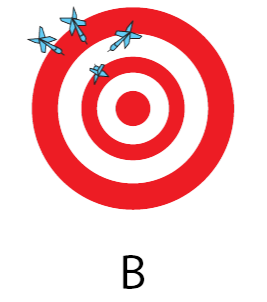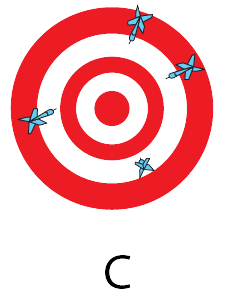Instructions for Side by Side Printing
- Print the notecards
- Fold each page in half along the solid vertical line
- Cut out the notecards by cutting along each horizontal dotted line
- Optional: Glue, tape or staple the ends of each notecard together
CHEM 23: Statistics and Data Handling in Analytical Chemistry
front 1  | back 1 low accuracy, low precision |
front 2  | back 2 low accuracy, high precision |
front 3  | back 3 high accuracy, low preicison |
front 4  | back 4 high accuracy, high precision |
front 5 accuracy | back 5 agreement between a measured value and the accepted true value, how close would it be to the actual value |
front 6 ways to express accuracy | back 6 absolute error and relative error |
front 7 absolute error formula | back 7 measured value – true value |
front 8 relative error formula | back 8 ((measured value - true value)/(true value)) x 100% |
front 9 precision | back 9 degree of agreement between replicate measurements of the same quantity |
front 10 determinate errors | back 10 determinable and that presumably can be either avoided or corrected |
front 11 instrumental errors | back 11 faulty equipment |
front 12 example of instrumental error | back 12 uncalibrated glassware |
front 13 operative errors | back 13 personal errors |
front 14 example of operative error | back 14 mathematical error in calculation, misread of menisicus |
front 15 errors of the method | back 15 wrong method for an experiment |
front 16 example of error of the method | back 16 coprecipitation of impurities |
front 17 indeterminate errors | back 17 accidental or random errors |
front 18 what does indeterminate error show in a distribution? | back 18 bell curve or normal distribution |
front 19 significant figures | back 19 the number of digits necessary to express the results of a measurement consistent with the measured precision |
front 20 significant figure rule in addition and subtraction | back 20 use least significant decimal place |
front 21 significant figure rule in multiplication and division | back 21 use least significant figures |